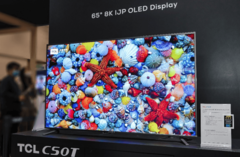TCL CSOT is reportedly preparing to build a massive 8.6-generation OLED production facility in Guangzhou, China.
According to a new report by UBI Research, construction of the so-called “T8” plant is expected to begin in October 2025, with equipment installation planned for late 2026. If the timeline holds, the factory could reach full-scale production by 2027.
While TCL CSOT hasn’t made any official announcements, UBI Research says the company has finalized plans for the facility and is ready to move forward. The factory will initially operate one 8.6G production line with a capacity of 45,000 glass substrates per month.
Once a second line is added, output could double to 90,000 substrates monthly. These large sheets, each roughly 2.29 by 2.62 meters, can be cut down to make displays for TVs, monitors, tablets, and smartphones.
That level of output would put TCL CSOT far ahead of its competitors. Samsung’s upcoming QD-OLED A6 line will reportedly max out at 15,000 substrates per month, while LG Display’s new Paju line is expected to reach between 7,500 and 15,000.
Chinese rival BOE has also announced plans for an OLED line with a 33,000 monthly substrate capacity. TCL CSOT’s target would make the T8 plant one of the largest OLED manufacturing facilities in the world.
Part of what sets TCL’s approach apart is its use of inkjet printing instead of the fine-mask evaporation process used by LG and Samsung.
This technique precisely deposits red, green, and blue OLED materials onto the substrate, helping to reduce material waste and lower production costs by about 30 percent.
UBI Research says the T8 plant will cost around RMB 20 billion, or about USD 2.75 billion, which is relatively low given its planned capacity.
TCL CSOT has been developing inkjet-printed OLED technology for several years. The company first outlined its ambitions back in 2020, aiming to begin mass production by 2024. While that target hasn’t fully materialized, TCL began limited production last year.
In 2024, it shipped 21.6-inch 4K OLED panels made using its Gen 5.5 line and started rolling out monitor panels by November. By May 2025, TCL had showcased a complete range of inkjet-printed OLED prototypes, including displays for smartphones, laptops, and televisions.
UBI believes an official announcement is likely to come soon, possibly as early as this month. However, the report cautions that TCL CSOT still faces technical hurdles. These include improving panel brightness and lifespan, as well as achieving better large-area uniformity and higher production yields.
The inkjet printing process is still seen as less mature and reliable than the more established methods used by Korean display manufacturers.
Still, TCL’s strategy reflects a broader push by Chinese companies to challenge South Korea’s dominance in OLED display technology. BOE and Visionox are also investing heavily in alternative manufacturing methods.














